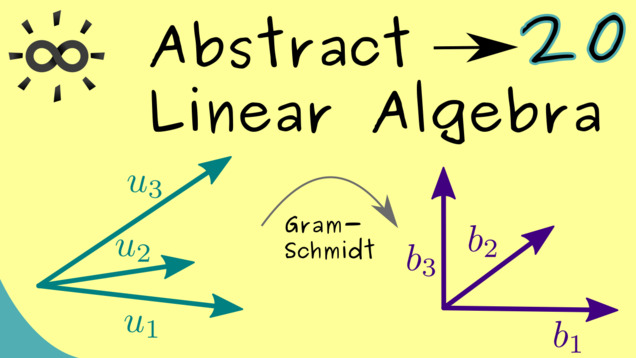
-
Title: Gram-Schmidt Orthonormalization
-
Series: Abstract Linear Algebra
-
Chapter: General inner products
-
YouTube-Title: Abstract Linear Algebra 20 | Gram-Schmidt Orthonormalization
-
Bright video: https://youtu.be/stm1GPBYA34
-
Dark video: https://youtu.be/EZ71YzZtZdI
-
Ad-free video: Watch Vimeo video
-
Original video for YT-Members (bright): https://youtu.be/wH3vLzlHQjc
-
Original video for YT-Members (dark): https://youtu.be/wRkRCgxLoFI
-
Quiz: Test your knowledge
-
Dark-PDF: Download PDF version of the dark video
-
Print-PDF: Download printable PDF version
-
Thumbnail (bright): Download PNG
-
Thumbnail (dark): Download PNG
-
Subtitle on GitHub: ala20_sub_eng.srt missing
-
Timestamps (n/a)
-
Subtitle in English (n/a)
-
Quiz Content
Q1: Let $V$ be a $\mathbb{F}$-vector space with inner product $\langle \cdot, \cdot \rangle$ and $U \subseteq V$ be a $k$-dimensional subspace. Which statement is always correct?
A1: There is an ONB for $U$.
A2: Each basis of $U$ is an ONB of $U$.
A3: There is a basis of $U$ with $k+1$ elements, which are mutually orthogonal.
A4: The Gram-Schmidt procedure is only applicable if $k \geq 2$.
Q2: Consider $V = \mathbb{R}^3$ together with the standard inner product. Let’s apply the Gram-Schmidt procedure to the basis $$ \left( \begin{pmatrix} 1\ 1 \ 1 \end{pmatrix}, \begin{pmatrix} 0\ 1 \ 0 \end{pmatrix}, \begin{pmatrix} 0\ 0 \ 1 \end{pmatrix} \right) $$ What is the correct approach in calculations here?
A1: You should change the order and apply Gram-Schmidt to $$ \left( \begin{pmatrix} 0\ 1 \ 0 \end{pmatrix}, \begin{pmatrix} 0\ 0 \ 1 \end{pmatrix}, \begin{pmatrix} 1\ 1 \ 1 \end{pmatrix} \right) $$ because then the first to steps are already done.
A2: You should just apply the algorithm without much thinking. So first we normalize $\begin{pmatrix} 1\ 1 \ 1 \end{pmatrix}$.
A3: You should just give up because Gram-Schmidt is impossible here.
-
Last update: 2025-02